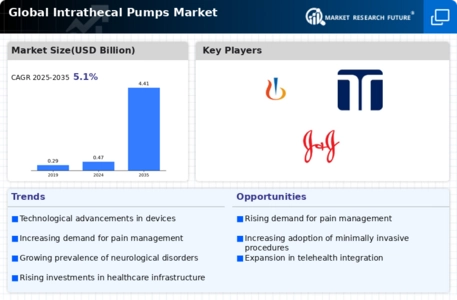Rising Geriatric Population
The increasing geriatric population is a significant factor driving the Intrathecal Pumps Market. As individuals age, they are more susceptible to chronic pain conditions, necessitating effective pain management solutions. The World Health Organization projects that the number of people aged 60 years and older will double by 2050, reaching over 2 billion. This demographic shift is likely to result in a higher demand for intrathecal pumps, as they provide targeted and effective pain relief for elderly patients suffering from conditions such as arthritis and cancer. Consequently, the growth of the geriatric population is expected to have a profound impact on the Intrathecal Pumps Market.
Rising Prevalence of Chronic Pain
The increasing prevalence of chronic pain conditions is a primary driver for the Intrathecal Pumps Market. Conditions such as cancer, neuropathic pain, and back pain are becoming more common, leading to a higher demand for effective pain management solutions. According to recent estimates, chronic pain affects approximately 20 percent of the adult population, which translates to millions of individuals seeking relief. Intrathecal pumps offer targeted drug delivery, which is often more effective than traditional oral medications. This trend is likely to continue, as healthcare providers increasingly recognize the benefits of intrathecal therapy in managing severe pain, thereby propelling the growth of the Intrathecal Pumps Market.
Advancements in Medical Technology
Technological advancements in the field of medical devices are significantly influencing the Intrathecal Pumps Market. Innovations such as improved pump designs, enhanced drug delivery systems, and advanced programming capabilities are making intrathecal pumps more efficient and user-friendly. For instance, the introduction of wireless technology allows for remote monitoring and adjustments, which enhances patient compliance and outcomes. The market is projected to grow as these technological improvements reduce complications and increase the effectiveness of pain management therapies. Furthermore, the integration of smart technology into intrathecal pumps may lead to more personalized treatment options, thereby expanding the market's potential.
Enhanced Patient Outcomes and Quality of Life
The focus on improving patient outcomes and quality of life is increasingly driving the Intrathecal Pumps Market. Intrathecal pumps are known for their ability to deliver medication directly to the spinal fluid, resulting in faster and more effective pain relief compared to traditional methods. This targeted approach not only alleviates pain but also minimizes side effects associated with systemic drug administration. As healthcare providers prioritize patient-centered care, the demand for intrathecal pumps is likely to rise. Studies indicate that patients using intrathecal therapy report higher satisfaction levels and improved quality of life, which further supports the growth of the Intrathecal Pumps Market.
Increasing Investment in Healthcare Infrastructure
The growing investment in healthcare infrastructure is another crucial driver for the Intrathecal Pumps Market. Governments and private entities are allocating substantial resources to enhance healthcare facilities, particularly in pain management and neurology departments. This investment is expected to facilitate the adoption of advanced medical technologies, including intrathecal pumps. As healthcare systems evolve, the demand for specialized pain management solutions is likely to rise, further stimulating market growth. Additionally, the establishment of pain management clinics and specialized treatment centers is anticipated to create a favorable environment for the Intrathecal Pumps Market, as these facilities often utilize advanced therapeutic options.

















Leave a Comment